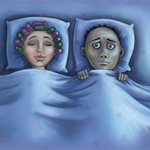
Jim Dowdalls/Science Source
When a patient has fibromyalgia, sleep troubles are the last thing they need. Unfortunately, sleep problems affect a large number of fibromyalgia patients, and those problems can turn into a vicious cycle that interplays with daytime pain and fatigue.
“Pain and sleep disturbances are a double-edged sword,” says Elika Kormeili, MFT, a licensed clinical psychologist in Los Angeles who helps treat patients with sleep problems. “The more pain you have, the more difficulty you have falling asleep and staying asleep. The less sleep you get, the more of a sleep deficit you have, which makes pain worse.”
“It’s been well documented that a lack of sleep lowers one’s pain threshold and magnifies pain perception,” says Inchel Yeam, MD, an internist at the MemorialCare Saddleback Medical Center in Laguna Hills, Calif., and board-certified in sleep medicine, pulmonary disease and critical care medicine. “Anything that increases pain in fibromyalgia patients could be detrimental.”
Lack of sleep also makes fatigue, cognitive and memory issues worse in those with fibromyalgia. And as sleep problems worsen—if, for example, a patient with fibromyalgia develops regular insomnia—anxiety and depression can develop or worsen, too, Ms. Kormeili says.
Fibromyalgia has had such a long-time link with sleep problems, it was once considered a sleep disorder, says Raj Dasgupta, MD, an assistant professor of clinical medicine at Keck School of Medicine of the University of Southern California in Los Angeles. That may not be the case anymore, but the two remain uneasy bedfellows.
There’s an increased awareness nowadays about sleep in general, and that’s prompting greater attention to sleep among those with fibromyalgia. “Most patients work hard, exercise and try to control their blood pressure, but there’s a whole eight hours at night that people forget [about],” Dr. Dasgupta says. “That’s why sleep is becoming more popular. More people are realizing that wellness is the big picture, and we need it at night and during the day.”
Diagnoses & Treatments
When a sleep specialist evaluates a fibromyalgia patient for sleep problems, they keep a few common problems in mind, such as obstructive sleep apnea (OSA). OSA is a common sleep disorder among fibromyalgia patients, says Robert S. Rosenberg, DO, the medical director at the Sleep Disorders Center in Prescott Valley, Ariz., and author of the book The Doctor’s Guide to Sleep Solutions for Stress & Anxiety. Snoring can be an easy tip-off, but sleep specialists will perform a sleep study and consider symptoms.
Another common OSA variant: Upper airway resistance syndrome, which doctors see more in women with fibromyalgia, Dr. Rosenberg says. “Their oxygen level doesn’t drop, but they do wake up,” he says.
Not all fibromyalgia patients are screened for OSA, but Dr. Dasgupta does keep it in mind. “If a fibromyalgia patient is getting seven to eight hours of sleep but isn’t refreshed, I have a low threshold to screen for OSA,” he says.
Doctors commonly treat OSA with a continuous airway pressure (CPAP) mask. Patients may have seen family members use bulky CPAPs and, in turn, resist getting one, but Dr. Dasgupta tries to reassure them. “Use of a CPAP does require a mask, but not all of them make you look like Darth Vader,” he says. Additionally, patients with OSA sometimes find success with positional therapy, a dental device or even surgery including tonsil removal instead of CPAP use. “Most of the older [surgical approaches] are not successful, but they still have a place for some patients,” Dr. Rosenberg says.
Sleep specialists also discuss the importance of weight loss and exercise when necessary with patients who have OSA, Dr. Dasgupta says. Often, patients with OSA feature other concurrent health issues, including obesity, cardiac disease and diabetes. Physicians also must evaluate whether the patient takes other medications that may make breathing worse, or if the patient has had undiagnosed OSA, he adds.
Treating OSA in fibromyalgia patients tends to be effective, Dr. Rosenberg says. “Fatigue improves significantly, and pain tends to diminish. Sleep becomes more consolidated, there are prolonged periods of REM sleep, and there’s more production of growth hormone.”
Restless leg syndrome (RLS) also frequently occurs among fibromyalgia patients, particularly among iron-deficient women and women of reproductive age, Dr. Dasgupta says. In fact, doctors see RLS in roughly 50% of fibromyalgia patients, he says. Symptoms include leg twitching that’s worse at night and when resting; movement relieves the feeling. Although RLS is not officially a sleep disorder, it does cause problems sleeping. “It’s not unusual for doctors to dismiss the symptoms and say it’s fibromyalgia pain,” Dr. Rosenberg says.
RLS requires identification of the root cause, such as iron deficiency, kidney problems or undiagnosed diabetes, and medications can treat it. And, as with OSA, treating RLS tends to help fibromyalgia symptoms.
Insomnia also commonly affects fibromyalgia patients. Ms. Kormeili is a certified insomnia therapist, which means she uses cognitive behavioral therapy (CBT) to treat insomnia. “Cognitive behavioral therapy focuses on changes in thoughts and behaviors that maintain sleep problems,” she says. Using CBT for insomnia can help fibromyalgia patients with their pain management.
She also incorporates laughter yoga and even gratitude exercises into her treatment. Use of CBT also tends to help clients gradually reduce their use of sleeping pills, she says.
In addition to treatments specific for common sleep problems, both sleep specialists and rheumatologists can cover some basic sleep solutions with fibromyalgia patients, such as:
- Keeping track of sleep habits and when sleep issues occur;
- Exercising regularly;
- Practicing good sleep hygiene with a regular and consistent sleep schedule, and using the bed only for sleeping;
- Performing meditation and relaxation techniques;
- Cutting back or stopping the use of artificial light and electronic devices at night;
- Trying melatonin, a natural sleep aid; and
- Focusing on the positive.
“When we are depressed, anxious or sleep-deprived and in chronic pain, we see the world with dark, gloomy glasses and tend to forget things that are going right,” Ms. Kormeili says. That’s why she’s found that such activities as gratitude awareness work especially well in fibromyalgia patients.
What About Sleeping Pills?
Experts from both rheumatology and sleep medicine tend to eschew sleeping pills for sleep treatment. “Brain waves on electroencephalography start to display unusual signals with many sleeping pills. It is increasingly becoming evident there are increased accidents and early dementia with long-term use of sleep medications,” Dr. Yeam says.1,2
He also says fibromyalgia patients usually have an increased exposure to physicians and medications compared with the general population, which can lead to an increased focus on trying to improve sleep through medications and gadgets. “All these can result in habits and preconceived ideas that may not be conducive to a healthy sleep routine,” he says.
“All sleeping pills are habit-forming and produce rebound insomnia after prolonged use. I believe it is best to avoid them or use them on a short-term basis,” says Anca D. Askanase, MD, MPH, the clinical director and founder of the Columbia University Lupus Center in New York City, and associate professor of medicine in the Division of Rheumatology at the Columbia University Medical Center, New York.
In addition to the aforementioned treatments, it’s important to give patients a better understanding of what a good night’s sleep is, Dr. Yeam says. “One of the myths I’d like to erase is that there is perfect sleep,” he says. “Perfect sleep, as most people define it, does not exist. Sleep is an active state with various stages. The brain does not slow down, nor does it shut off. Many parts of the brain are actively functioning.”
In turn, there’s frequent switching at night from sleep to brief wake modes. “Basically, sleep is not perfect. We wake, toss and turn. This is found in normal, healthy sleep,” he says.
How Can You Help?
Naturally, many rheumatologists are already swamped and can’t devote too much time to helping patients with fibromyalgia or any rheumatological condition sleep better. However, there are a few things they can do to start the discussion, according to sleep experts.
First, to ensure the best care for your fibromyalgia patients, make sure a team of health professionals evaluates them. “The care of fibromyalgia patients includes skilled professionals, a psychologist, a physical therapist, a psychiatrist and a sleep specialist, in addition to the primary care physician and rheumatologist,” Dr. Askanase says. “Understanding the need for a team approach is critical to good outcomes in fibromyalgia.”
Next, short questionnaires online, such as the STOP-Bang and Berlin, can help OSA evaluation. “If you have patients fill it out in the waiting room, it takes about four minutes and helps identify OSA. Even your medical assistant can give it,” Dr. Rosenberg says. Such questionnaires may help determine who needs a referral to a sleep specialist.
In addition to a questionnaire, you can ask some simple sleep questions when evaluating a patient. “How are you sleeping?” is an easy one Dr. Dasgupta recommends. You can also ask about how much sleep the patient is getting, and how many times they wake up at night, Dr. Rosenberg says.
Finally, consider referring to a sleep specialist sooner rather than later for help. Dr. Rosenberg says he’s surprised by the number of rheumatologists and neurologists who don’t ask about sleep issues at all, and who tend to ignore or mischaracterize a patient’s RLS symptoms.
With a bigger picture approach to sleep quality, fibromyalgia patients can improve their symptoms and quality of life.
Vanessa Caceres is a medical writer in Bradenton, Fla.
References
- Gray SL, Anderson ML, Dublin S, et al. Cumulative use of strong anticholinergics and incident dementia: A prospective cohort study. JAMA Intern Med. 2015 Mar;175(3):401–407.
- Hansen RN, Boudreau DM, Ebel BE, et al. Sedative hypnotic medication use and the risk of motor vehicle crash. AJPH. 2015 Aug;105(8):e64–e69.

